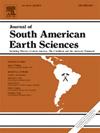Weathering assessment through geochemical modeling: A quantitative approach in Eastern Sierras Pampeanas (Northwest Argentina)
IF 1.7
4区 地球科学
Q3 GEOSCIENCES, MULTIDISCIPLINARY
引用次数: 0
Abstract
The Sierra de Velasco (Eastern Sierras Pampeanas, Argentina) offers an ideal setting to investigate chemical weathering in granitic semi-arid catchments characterized by a “weathering-limited” erosional regime. Geochemical proxies and inverse modeling techniques were applied to quantitatively assess weathering processes through both solid materials and dissolved load of rivers. Chemical Index of Alteration (CIA) values ranging from ∼53 to ∼60 reflected incipient surface weathering in the exposed granitic rocks. The composition of dissolved phases indicated silicate alteration mainly controls the hydrochemistry of river waters. Inverse modeling results showed that the incongruent hydrolysis of plagioclase and micas are the dominant weathering reactions, accounting for over 30 % of the total mass transfer between solid and aqueous phases. Kaolinite and illite were identified as the main weathering products. Elevated concentrations of dissolved F− were controlled by the dissolution of F-rich biotite (∼2 % of the mass transfer) with minor contributions from fluorite and fluorapatite (<1 %). CO2(g) consumption represented approximately 35 % of the total transferred phases by weathering reactions. These findings may be used in weathering assessments of other granitic catchments in mid-latitude and extra-tropical regions. Last, these results highlight the role of weathering processes in CO2 sequestration, even where chemical alteration remains at an early stage.
利用地球化学模拟进行风化评价:一种定量方法
Sierra de Velasco(阿根廷东部的Sierra Pampeanas)为研究花岗岩半干旱流域的化学风化提供了理想的环境,其特征是“风化有限”的侵蚀机制。应用地球化学指标和反演模拟技术定量评价河流固体物质和溶解负荷的风化过程。化学蚀变指数(Chemical Index of蚀变)在~ 53 ~ ~ 60之间,反映出出露花岗岩的早期地表风化作用。溶解相组成表明,硅酸盐蚀变主要控制了河流水体的水化学。反模型结果表明,斜长石和云母的不一致水解是主要的风化反应,占固水两相总传质的30%以上。确定高岭石和伊利石为主要风化产物。富F黑云母的溶解控制了溶解F-浓度的升高(约占传质量的2%),萤石和氟磷灰石的溶解作用较小(约占1%)。CO2(g)消耗约占风化反应总转移相的35%。这些发现可用于中纬度和热带外地区其他花岗岩集水区的风化评价。最后,这些结果强调了风化过程在二氧化碳封存中的作用,即使化学变化仍处于早期阶段。
本文章由计算机程序翻译,如有差异,请以英文原文为准。
求助全文
约1分钟内获得全文
求助全文
来源期刊

Journal of South American Earth Sciences
地学-地球科学综合
CiteScore
3.70
自引率
22.20%
发文量
364
审稿时长
6-12 weeks
期刊介绍:
Papers must have a regional appeal and should present work of more than local significance. Research papers dealing with the regional geology of South American cratons and mobile belts, within the following research fields:
-Economic geology, metallogenesis and hydrocarbon genesis and reservoirs.
-Geophysics, geochemistry, volcanology, igneous and metamorphic petrology.
-Tectonics, neo- and seismotectonics and geodynamic modeling.
-Geomorphology, geological hazards, environmental geology, climate change in America and Antarctica, and soil research.
-Stratigraphy, sedimentology, structure and basin evolution.
-Paleontology, paleoecology, paleoclimatology and Quaternary geology.
New developments in already established regional projects and new initiatives dealing with the geology of the continent will be summarized and presented on a regular basis. Short notes, discussions, book reviews and conference and workshop reports will also be included when relevant.
 求助内容:
求助内容: 应助结果提醒方式:
应助结果提醒方式:


